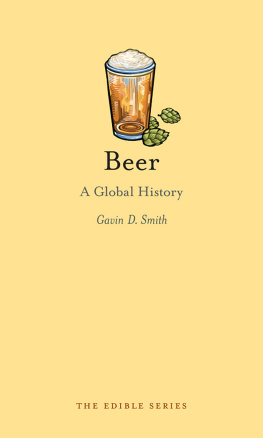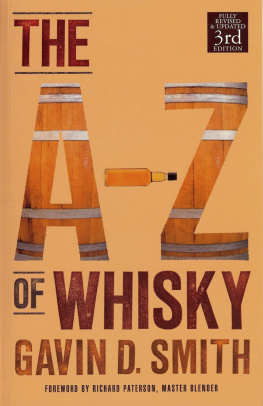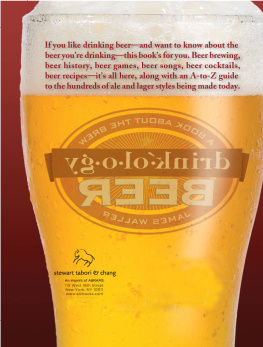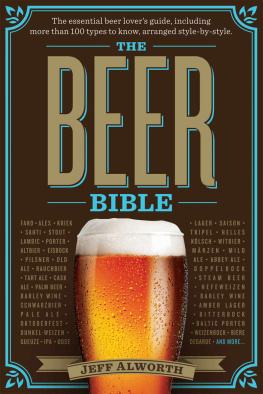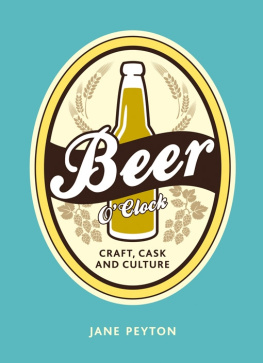Series Editor: Andrew F. Smith
Copyright Gavin D. Smith 2014
Introduction

It takes beer to make thirst worthwhile.
German proverb
Beer is the most popular alcoholic drink in the world, with a history stretching back perhaps as far as 10,000 BC, and with almost every country boasting some sort of brewing heritage. While other forms of alcohol tended traditionally to be limited in their spread and influence by climatic and geographical factors you can only make wine if you are able to grow grapes beer is ubiquitous and its essential ingredients, in one form or another, can be found almost everywhere.
The popularity of beer throughout the ages has been due to a number of factors. First is the aforementioned fact that it could be made, and second its comparative affordability, making it a drink for the everyman. Third, it had immense value as a drink that would not infect the imbiber with cholera, typhoid or any of the other diseases easily contracted from polluted water sources, at a time when clean drinking water was outwith the reach of many. Remarkable though it may seem from a modern perspective, from 1687 to 1860 patients at St Bartholomews Hospital in London were each allocated three pints of beer per day, made in the hospitals own brewery.Beer also had significant nutritional value not for nothing has it been been referred to as liquid bread but perhaps its ultimate attraction has always been its intoxicating nature, imparting a feeling of relaxation and well-being, provided consumption is kept within sensible limits.
And that consumption, on a worldwide scale, is really quite remarkable. According to the Kirin Institute of Food and Lifestyle Report of 2011, during 2010 global beer consumption amounted to 182.69 million kilolitres, the equivalent of 288.6 billion 633-millilitre bottles. This was an increase of 4.33 million kilolitres (or 6.84 billion 633-ml bottles), or 2.4 per cent, over 2009, marking the 25th consecutive annual increase.
As we will see, the actual character of the beer consumed around the world has changed significantly over the centuries, as have methods of manufacture and the manner and occasion of its consumption. In the pages that follow we will not only chart the history of beer around the world, highlighting some of the greatest beer-making and beer-drinking nations, but also examine the drinks cultural associations and its versatility as an accompaniment to a wide variety of foods. We shall focus on the specific heritage of some of the globally best-known brands, not to mention indicating some of the best places to read about beer, find out more about its heritage and meet up with like-minded beer drinkers.
Beer has made a long journey from its origins in around 10,000 BC to the twenty-first century, but arguably there is now more diversity in, commitment to and passion for the subject than there has been for a very long time, and drinkers have lots of reasons for optimism. So pour yourself a glass of whatever style and brand takes your fancy, and join me as we explore the global history of beer.
1
Origins

He was a wise man who invented beer.
Plato
Like so many ancient crafts, the origins of brewing are somewhat lost in the mists of time. A persuasive case can be made for the first brewers being Neolithic people in what we know today as Kurdistan within the modern countries of Turkey, Iraq and Iran. These people were cultivating crops from around 10,000 BC and are thought to have developed the ability to make beer after accidentally discovering the malting process. Perhaps they dried grain which had become damp and started to sprout in order to preserve it, only to find that it released the enzymes essential to convert the grains starch into fermentable sugars. Inevitably, qualifications such as maybe and perhaps occur frequently in any discussion about what happened so very long ago.
It has been suggested that brewing and other methods of creating alcoholic drinks probably developed independently across Asia, Africa and the Americas, involving whatever grain crops or fruits were locally cultivable; there is an anthropological viewpoint that suggests nomadic lifestyles were sacrificed in order to cultivate crops, principally for the production of beer. This is surely a possibility, given the seductive powers of alcohol, once encountered!

Print of Ugandan Africans drinking millet beer, c. 1900.
The first nomadic hunter-gatherers to settle and grow crops are thought to have been the Sumerians, who occupied land between the Tigris and Euphrates rivers in what is now Iran and Iraq. Regarded as the first really significant civilization of the Middle East, the Sumerians invented the wheel and the art of writing. Indeed, more than 5,000 years ago, they recorded on a series of clay tablets a range of beer types and recipes, contained within the ancient text A Hymn to Ninkasi. The name Ninkasi means the lady who fills the mouth, and as well as being the goddess of brewing, Ninkasi was also their goddess of fertility, harvest, love-making and the waging of war. Ninkasis nine children were each named after the potential effects of alcohol, including sons known as the brawler and the boaster.

